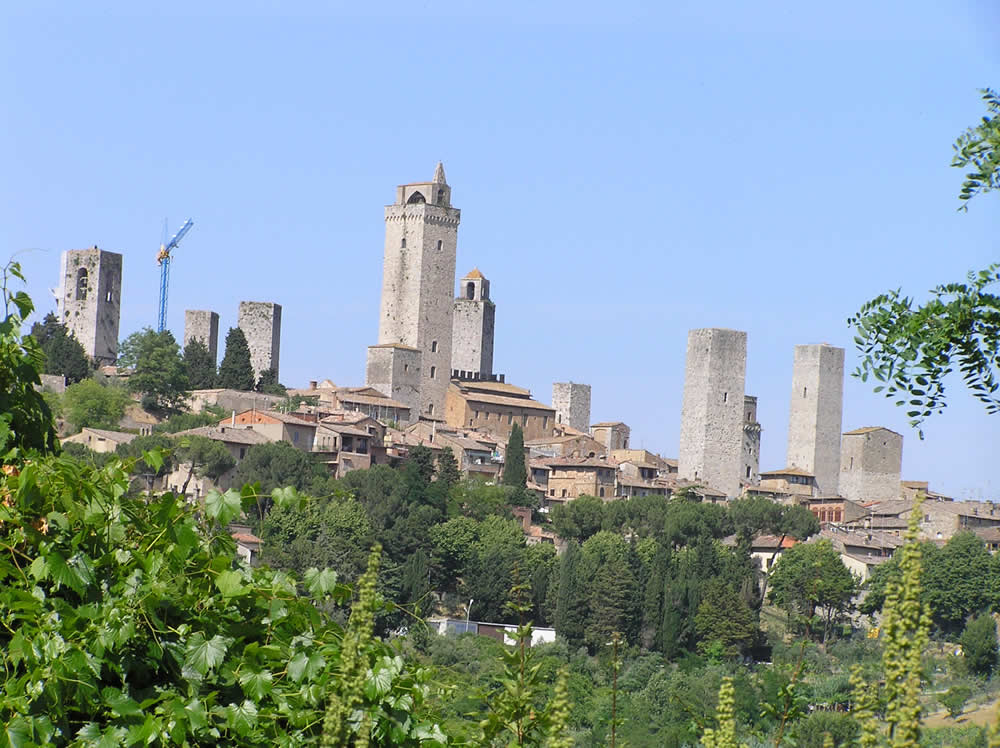Questo articolo è disponibile anche in:
![]() Français
Français ![]() Deutsch
Deutsch ![]() Español
Español ![]() Italiano
Italiano
San Gimignano was built in the 8th century as a walled feudal castle. In the following centuries the village became a free municipality. Then in 1353 the town became part of the possessions of the Republic of Florence.
In the Middle Ages San Gimignano was an important stop for pilgrims who went to Rome along the Via Francigena. In the fourteenth century San Gimignano reached its heyday. During this period the patrician families who controlled the city built about 72 tower-houses (some up to 50 m high) as symbols of their wealth and power.
Although only 14 tower-houses have survived, San Gimignano maintains its medieval atmosphere. The town also houses several masterpieces of Italian art of the fourteenth and fifteenth century including works by Benozzo Gozzoli, Ghirlandaio and Pollaiuolo.
In 1990, the historic center of San Gimignano has been included in the UNESCO list of World Heritage sites.
Now we begin our walk to San Gimignano: A walk to San Gimignano.
[divider]
[divider]
PIAZZA SANT’AGOSTINO
Our route begins from the north side of the town, from the road that arrives from Certaldo we reaches to a parking (to payment, parking number 3) where is possible to leave the car (other parkings are all around the town). From here we entered inside of the town; on the left is the San Jacopo Gate, with the Romanesque church os San Jacopo (13th century).
Returning behind, covering via Folgore da San Gimignano on the left it’s the Hospital of Santa Fina (1203) and more ahead to the right we find the Conservatory of Santa Chiara seat of Polo Museale di Santa Chiara (Archaeological Museum, Spezieria di Santa Fina, Gallery of Modern and Contemporanean Art) and of the communal Library, continuing beyond and entering the first road to the right we will find ourselves in Sant’Agostino square where first of all we will visit the Romanesque church of San Pietro (11th century), from the simple facade with rose-window, the inside has a single nave and frescoes of 14th century.
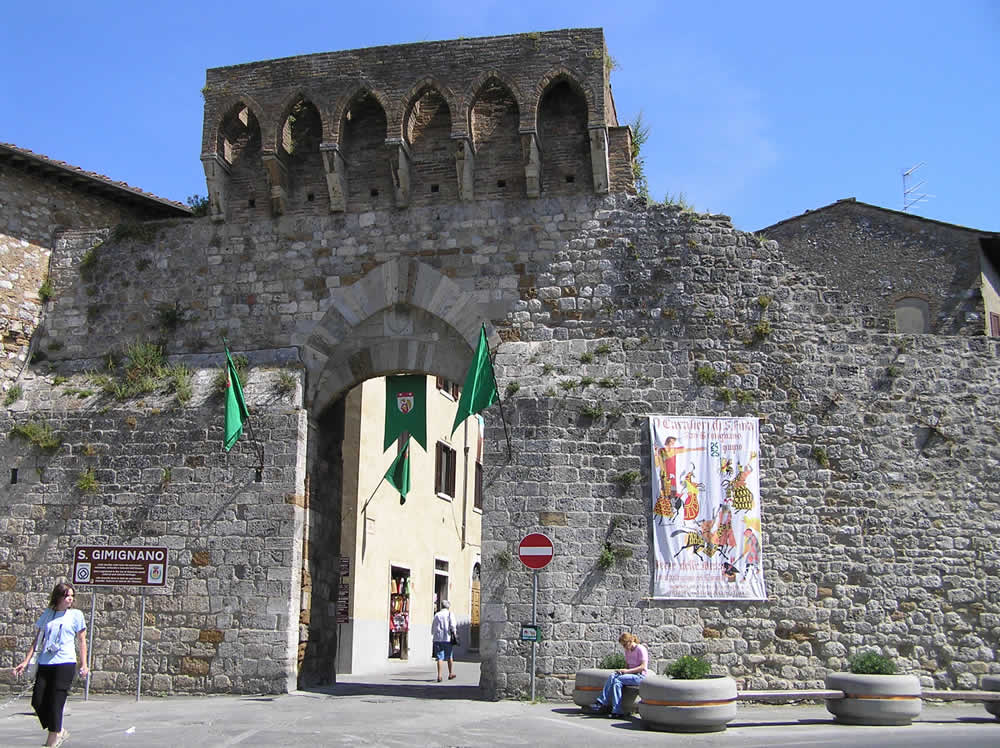
THE CHURCH OF SANT’AGOSTINO
In the same square it’s the imposing Romanesque-gothic church of Sant’Agostino (1280-1298) with a simple facade with rose-window. The interior of this church to a single nave and encloses interesting works of art: in the Chapel of San Bartolo it’s a marble altar, work of Benedetto da Maiano (1494). In the Presbytery are the more important works: over the main altar it’s a masterpiece of Piero del Pollaiolo executed in 1483, that represents the coronation of Maria and others saints, on the walls over the chorus are frescoes of Benozzo Gozzoli (1464-1465) that represent the life of Sant’Agostino.
Others frescoes of Benozzo Gozzoli, Sebastiano Mainardi, Lippo Memmi and Vincenzo Tamagni are present along the left wall. Interesting is also the 15th century cloister.
[divider]
[divider]
VIA SAN MATTEO
Finished the visit of the church of Sant’Agostino, we continue until the San Matteo Gate (1262). From we entered in the via San Matteo, we covered approximately 150 meters in steep slope along one of the more characteristic street of San Gimignano. Along the street we will be able to observe some interesting medieval palaces like the Vichi palace, the Tinacci palace, the Mori palace, the Lorini palace, the house-tower Pesciolini (13th century). Next are the Romanesque church of San Bartolo (13th century) and then the Marsili palace (known also like palace of the Papal chancellery) of the end of 13th century.
We are arrived at the ancient gate of the first town walls, porta della Cancelleria, a beautiful double gate, and then to the palace and tower Pettini. We are at last arrived to the end of the slope and in front of our eyes is opened the piazza del Duomo, than together with the adjacent piazza della Cisterna it’s the heart of San Gimignano.
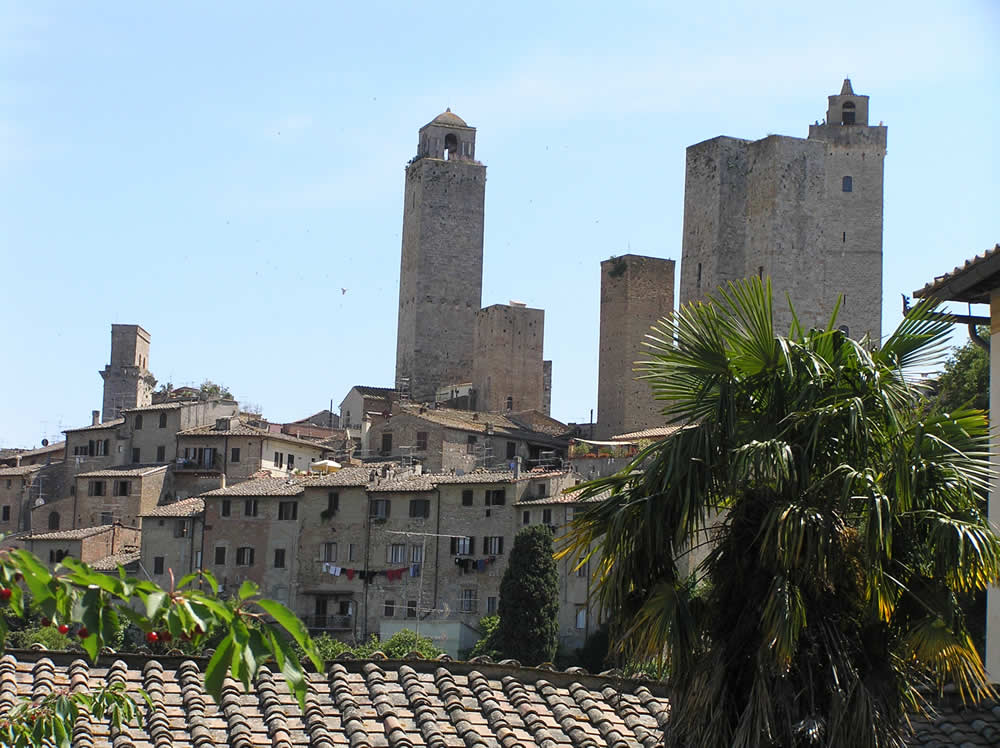
[divider]
[divider]
PIAZZA DEL DUOMO
Piazza del Duomo, is the heart of San Gimignano and its monumental center. It’s sure one of the more beautiful small squares of Italy. Here face many interesting palaces (palazzo del Podestà, palazzo del Popolo, the Cathedral, the Loggia) and various medieval towers (Rognosa tower, Chigi tower, Grossa tower, the two Salvucci towers) that gives to the city the aspect of a medieval New York.
THE CATHEDRAL
On the western side, the square is dominated from the Romanesque, 12th century, facade of the Cathedral of Santa Maria Assunta, situated to the end of a beautiful staircase. The inside of the church is with three aisles with a vaulted roof, the walls and the vaults are all frescoed from wonderful frescoes executed between the others by Benozzo Gozzoli, Jacopo della Quercia, Lippo Memmi, Taddeo di Bartolo, Barna da Siena and Bartolo di Fredi.
In the inner facade is a fresco that represents the martyrdom of Saint Sebastian by Benozzo Gozzoli. Deserve particular attention the frescoes of Barna da Siena that are on the lateral wall of the left aisle and that illustrates the New Testament. At the end of the right aisle is the wonderful Chapel of Santa Fina (1468), masterpiece of the Renaissance work of Benedict and Giuliano da Maiano, remarkable, on the sidewalls of the Chapel, are two frescoes (1475) of Domenico Ghirlandaio.
On the left aisle it’s another cycle of frescoes of 14th century executed from Bartolo di Fredi and that represent Old Testament.
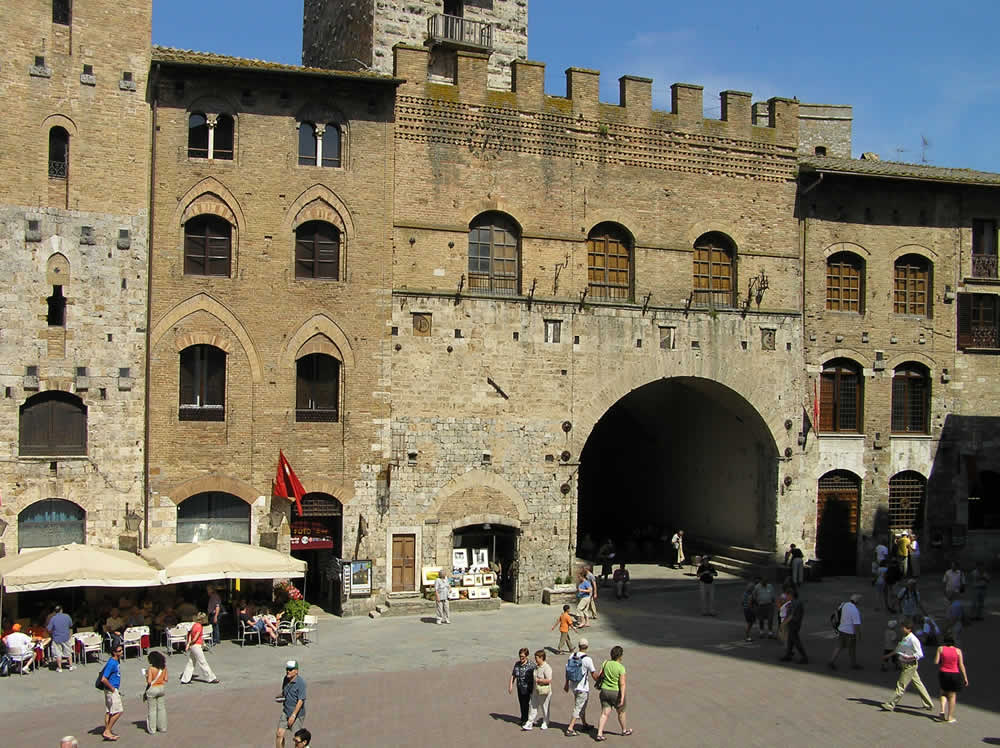
PALAZZO DEL PODESTÀ
In the same square, from the opposite side of the Cathedral, it’s the Palazzo del Podestà built in 1249 and enlarged in 1337, with a great facade in stone and local brickwork, the palace is dominated from the tower of the Rognosa, 51 meters high, that until the 14th century, it was used like prison.
The entrance to the palace is through an enormous vault, call the Loggia, where is a wide entrance-hall, with seats in stone, in bottom to which it’s a fresco of the Sodoma (1513), that it represents the Madonna with the Child and the saints Geminiano and Nicholas. There is also a main gate that gives access the small Theatre of the Leggieri. Sideways to the Palazzo del Podestà it’s the Chigi tower built in 1280. The two twin towers of the Salvucci complete the vision of this part of the square.
[divider]
[divider]
PALAZZO DEL POPOLO HEADQUARTERS OF THE MUNICIPALITY
The Palazzo del Popolo or Palazzo Nuovo del Podestà, today head office of the Common, is one of the most important monuments in San Gimignano, it rises on the south side of the square of the Cathedral, and was built in 1288 and subsequently enlarged. The entrance to the palace is from the beautiful courtyard of 14th century with frescoes of the Sodoma, from here with an external scale we entered in the Civic Museum. This museum accommodates painting of the florentine and sienese schools of the 13th, 14th and 15th century of masters like Coppo di Marcovaldo, Pinturicchio, Benozzo Gozzoli, Niccolò Tegliacci, Taddeo di Bartolo, Guido da Siena, Domenico Michelino and Filippino Lippi.
In the museum are also visible the Sala of Dante and the Room of the Podestà, decorated with famous cycles of frescoes like that of Memmo di Filippuccio, inside of the Room of the Podestà, and the scenes of huntings and tournament, attributed to painter Azzo di Masetto and the great Maestà of Lippo Memmi, in the Sala of Dante, the ancient Room of the Council. The visit finishes with the Torre Grossa built in 14th century, the highest of the city (54 meters), from which it’s possible to enjoy a panorama that spaces on great part of the Tuscany: from the Apuan Alps, to the Appennino mountains, untill the hills of the Chianti.
Returned in the public square we stop in the three arched Loggia situated at the angle between the piazza del Duomo and piazza della Cisterna, the Loggia has interesting frescoes of 14th century that represents the Madonna with the child, the Archangel and Saint John Baptiste.
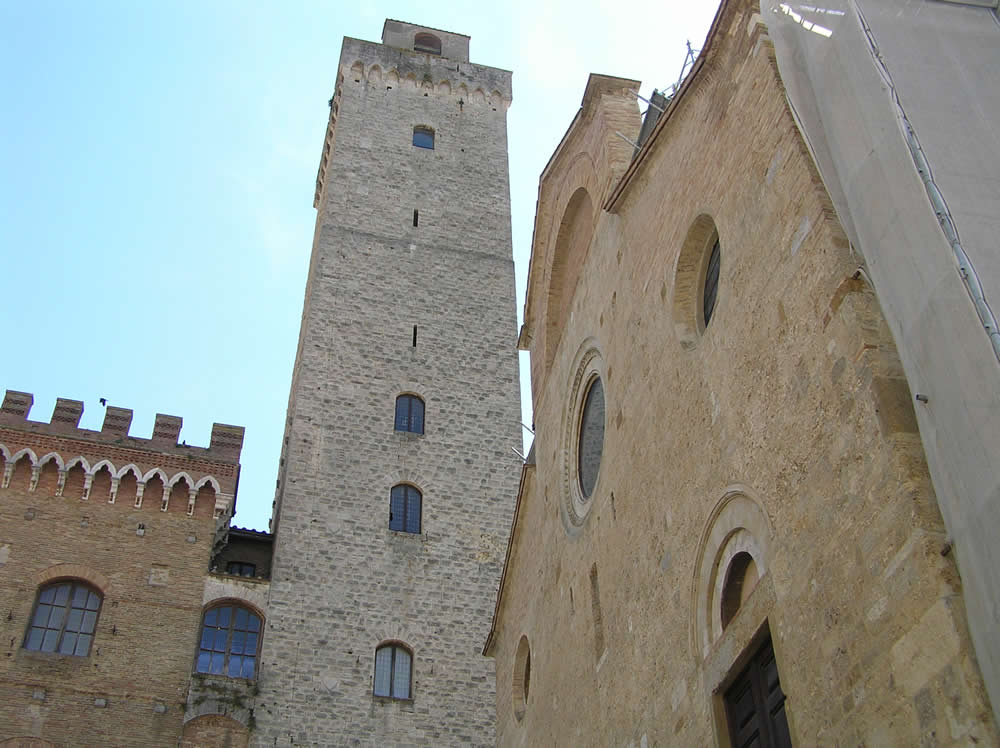
PIAZZA DELLA CISTERNA
At the corner where is the Loggia, opens the passage between the Piazza del Duomo and Piazza della Cisterna. This last square, triangular, owes its name precisely to the reservior of the thirteenth century which still lies in its center. The whole square is surrounded by interesting buildings and beautiful medieval towers, which make it a more picturesque corner of San Gimignano (among others in recent years, some commercials spots were shot in the square).
The magical atmosphere that breathes filler the visitors behind in the time. Palaces and towers, alternating themselves, irregularly encircle the triangular space of the public square that is shrunk towards via del Castello. On the right, watching via del Castello, are the Razzi House, the Tortoli Palace, with its elegant four mullioned windows (14th century), the truncated Tower of the Pucci from the name of the family that possessed it between the 19th and 20th century. Then they are found the Albergo della Cisterna, the Ridolfi Palace and the towers and the houses of the Becci and Cugnanesi. Then the Pellari palace and, with its two towers, the Ardinghelli palace.
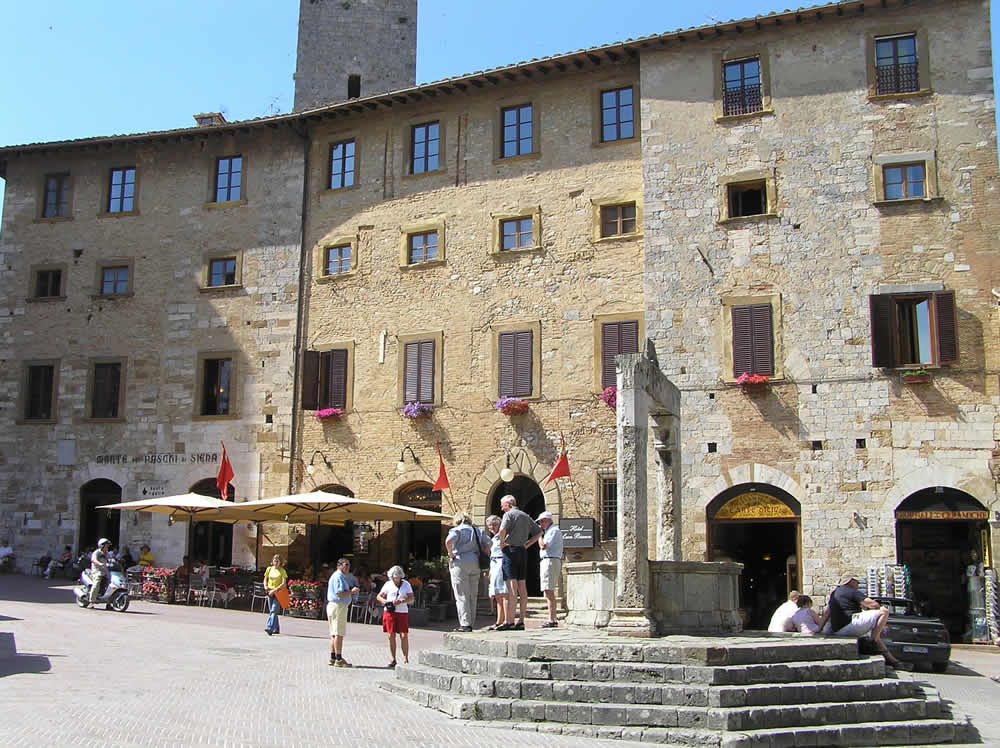
From the other side of the square the Lupi palace with the tower of the Diavolo and after the vicolo dell’Oro, where in past the goldsmith had their rich jeweller’s shops, the 15th century Cortesi-Lolli palace. On the western side of the square (that it watches towards the Palazzo del Popolo) are the Semplici and Magazzini houses and the towers of the Ardinghelli.
VIA SAN GIOVANNI
Continuing in descent towards via San Giovanni, the Arch of the Becci is crossed, it’s an ancient door of the first town walls (to right is the evocative Vicolo dei Becci). From here it’s reached the piazza dei Cugnanesi with the homonymous palace and tower, that offer to the visitor another wonderful scene. On the right is via Quercecchio from which is beautiful sight on the Torre Grossa.
Continuing in light descent along via San Giovanni are others interesting medieval palaces like Palazzo Pratellesi. More ahead is reached on the left the church of San Francesco (13th century), or better that remains of it, infact closed between two bricks houses, remains only the beautiful Romanesque-pisan facade in white travertine, furrowed horizontally from dark lines of serpentine, with the doorway surmonted from a double arch with the symbol of the Knights Hospitaler.
Get over the church of the convent of San Francesco, remains to see a shrine with a fresco of Sebastiano Mainardi and then the Porta San Giovanni, built in 1262 in sienese style with lowered arch, nearby is the church of the Madonna dei Lumi (17th century).
Now we pass to visit of the fortification and the defense works of the town, that deserve a their own page. The tour continues to the medieval walls. —>
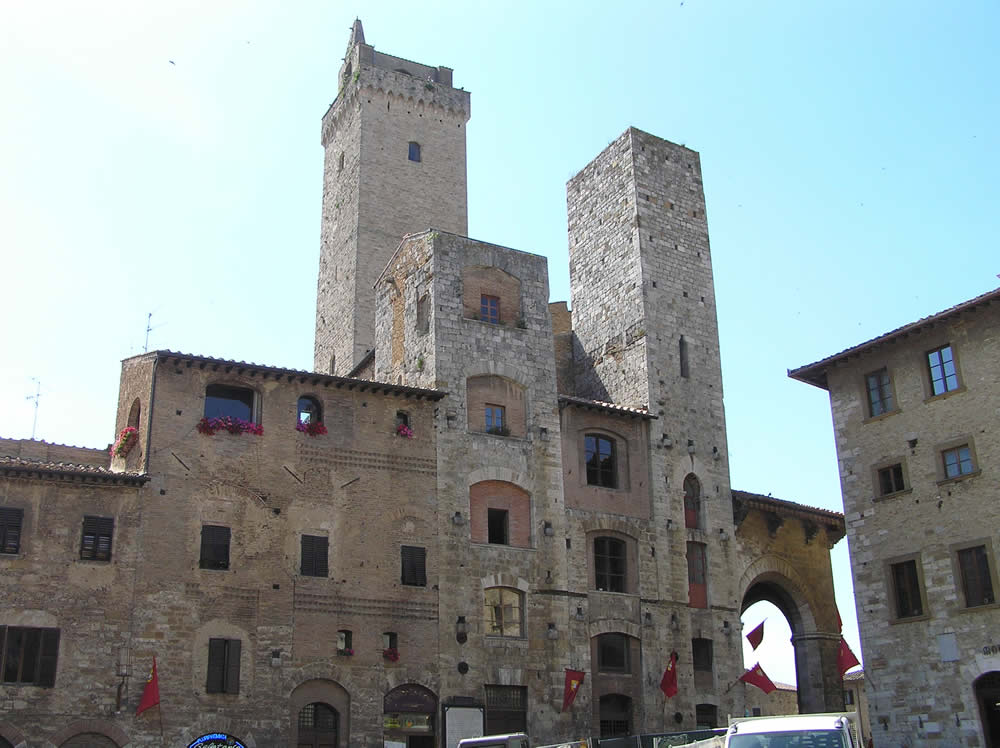
MUSEUMS OF SAN GIMIGNANO
In the historical center of San Gimignano are found several interesting museums: the Civic Museum with the Pinacoteca and the Torre Grossa, the Basilica of Santa Maria Assunta and the Chapel of Santa Fina, the Museum of Sacred Art, the Ornithological Museum, the Archaeological Museum, the Gallery of Modern and Contemporary Art, the Spezieria di Santa Fina. The entrance to the museums is facilitated from the existence of a cumulative ticket of the cost of 7.50 €.
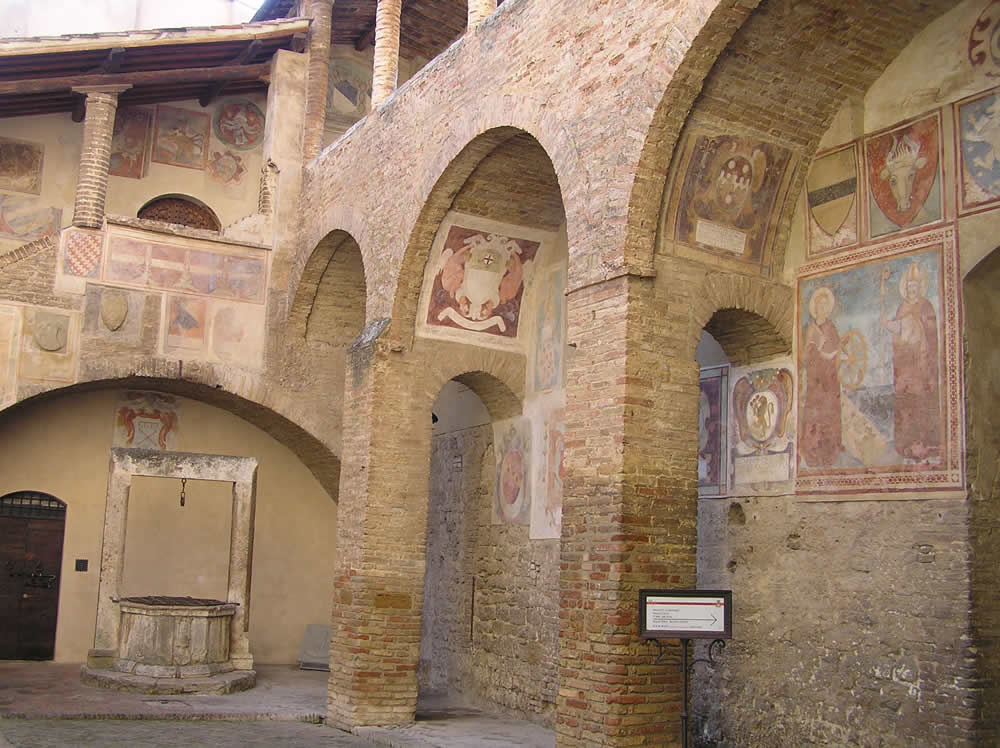
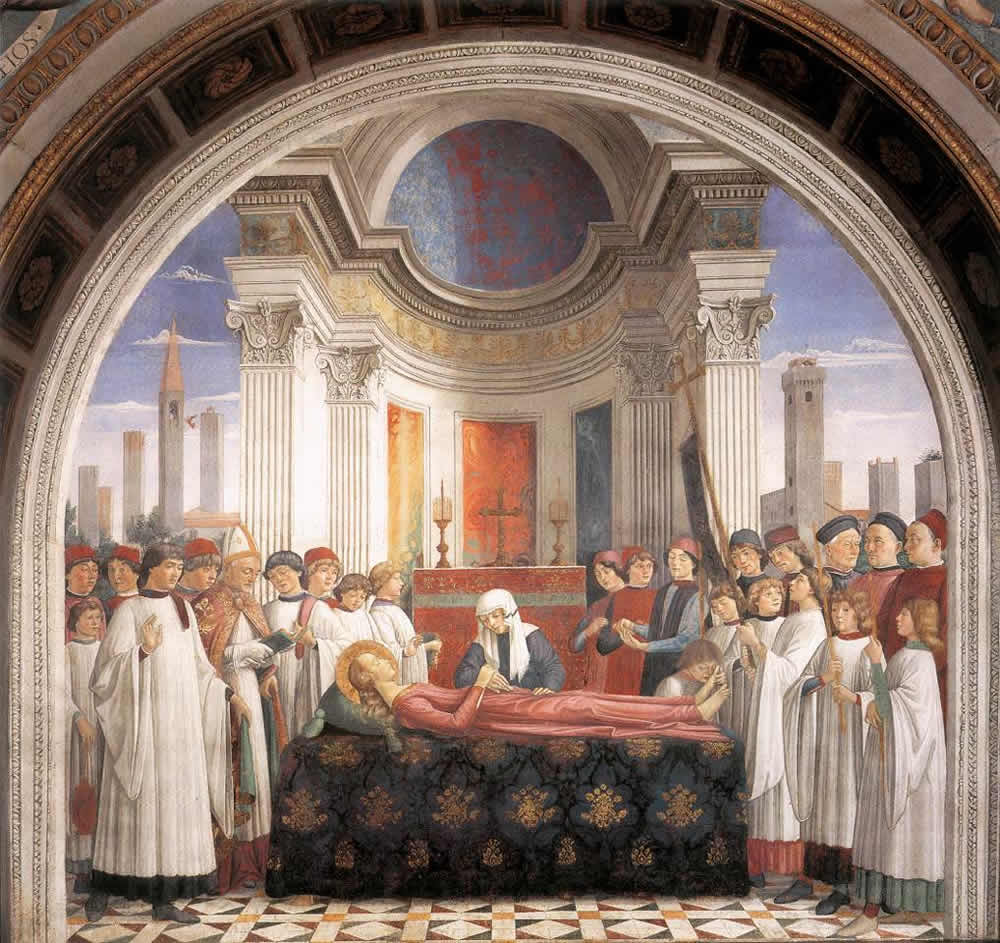
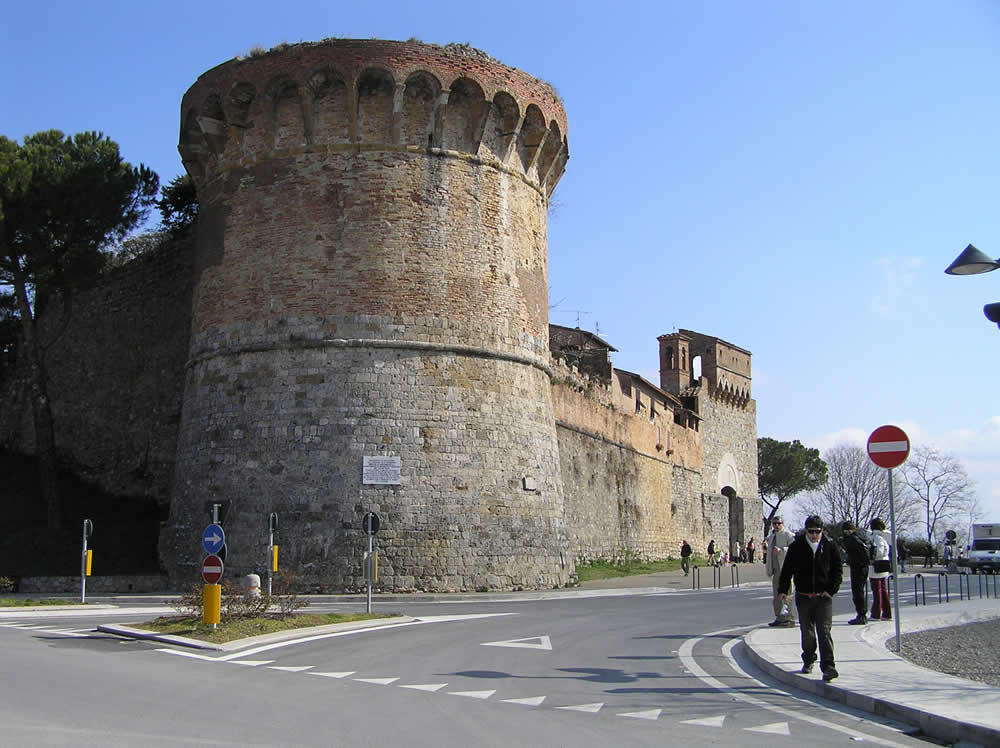
HOW TO GET TO SAN GIMIGNANO
San Gimignano, “the city of beautiful towers” is located in the heart of Tuscany, 56 km south of Florence and 40 km north-west of Siena.
Car: To reach San Gimignano, coming from Florence, take the Raccordo Autostradale Firenze-Siena (at the exit Florence-Certosa of the A1) and after 30 km exit at Poggibonsi Nord, from here continue for about 13 km follow the signs to San Gimignano.
Coming from Siena, always with the Raccordo Autostradale Florence-Siena, exit Poggibonsi Nord and then follow the indications for San Gimignano (from the exit are approximately 13 km).
From Pisa, take the SGC FI-PI-LI direction Florence, exit at Empoli Ovest and from there continue along the SS 429 to Certaldo, then follow the signs to San Gimignano.
Road distances from San Gimignano: Certaldo 12 km, Poggibonsi 13 km, Barberino Val d’Elsa 21 km. Volterra 30 km, Siena 40 km, Florence 56 km, Pisa 76 km, Lucca 76 km, Massa Marittima 83 km, Arezzo 118 km.
Bus: San Gimignano is regularly served by numerous daily buses of SITA and Train that connects it to Florence, Siena and Poggibonsi. Some buses between Barberino Val d’Elsa, Siena, Poggibonsi are also operated by Train buses. Generally to get to San Gimignano have to change buses at Poggibonsi.
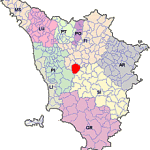
Train: The closest station to San Gimignano is that of Poggibonsi on the railway line Empoli-Siena, which is only 13 km away. Poggibonsi it is connected by multi bus services with San Gimignano. The main station of Florence (Santa Maria Novella) is 56 km away.
Air: The nearest airport is Florence-Peretola Amerigo Vespucci, which is located 65 km away. The airport of Pisa Galileo Galilei is located 73 km away.
USEFUL INFORMATION:
Weekly Market San Gimignano: Thursday
Piazza Duomo, Piazza della Cisterna 8.00-13.00
Tourist Information Office
Ufficio Informazioni Pro Loco
Piazza Duomo, 1
tel. +39 0577 940008 – fax +39 0577 940903
BIBLIOGRAPHY
- AA. VV. “Toscana” Guide Rosse Touring Club Italiano, 2007.
- Cur. Mennucci A. “San Gimignano. Musei civici, palazzo comunale, pinacoteca, torre Grossa” 2010, Silvana.
- Balestracci Duccio “Breve storia di San Gimignano” 2007, Pacini Editore.
- Grassi Paola “San Gimignano. Il centro storico” 2002, Ist. Poligrafico dello Stato.
[divider]
[divider]
Questo articolo è disponibile anche in:
![]() Français
Français ![]() Deutsch
Deutsch ![]() Español
Español ![]() Italiano
Italiano

